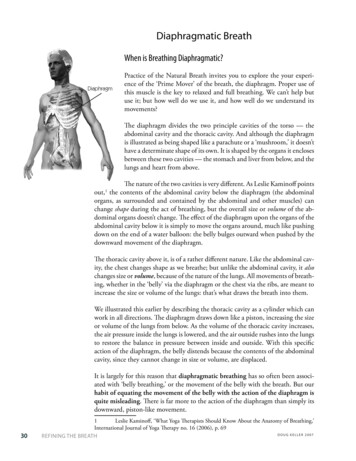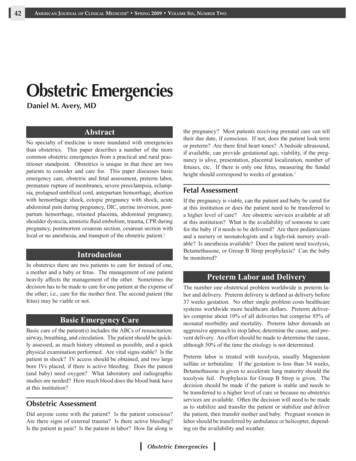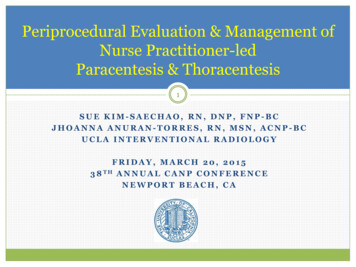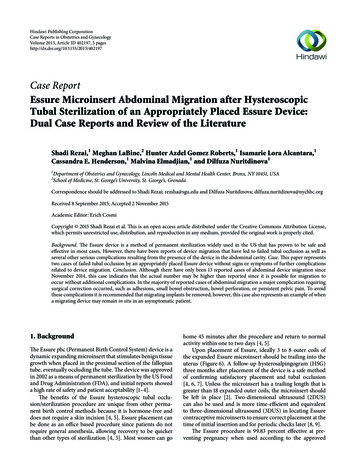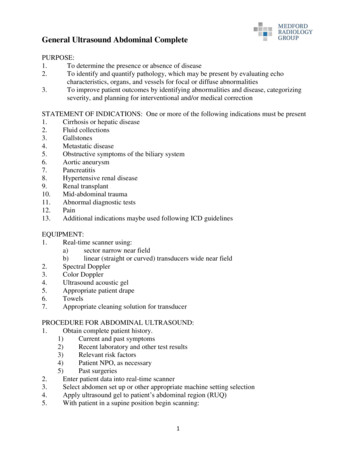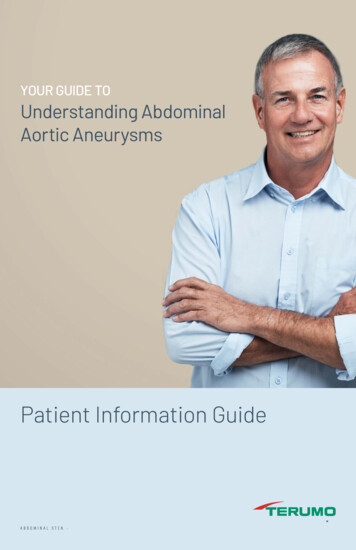
Transcription
YOUR GUIDE TOUnderstanding AbdominalAortic AneurysmsPatient Information Guide
2
Table of ContentsIntroduction . 4Abdominal Aortic Aneurysm . 4Prevalence and Causes. 5Symptoms . 5Treatment . 6The Terumo Aortic difference . 8TREO Clinical Study Summary . 11Your recovery . 12Questions to ask your doctor . 14Your questions . 14Where can I get more information? . 15Glossary . 16Your notes . 18Indications For Use . 19Contraindications of Use for the TREO System . 19MRI Safety Information . 19Helpful hintsTo help you learn more about your Abdominal Aortic Aneurysm, you’ll notice somewords and terms highlighted with a dotted underline, so you’ll know you can findtheir meanings in the Glossary section near the back of this guide.3
IntroductionThis educational information is provided by Terumo Aortic to help youmake an informed decision about the TREO Abdominal Aortic Stent-GraftSystem to treat your Abdominal Aortic Aneurysm (AAA).Since gaining initial European approval in 2015, the TREO Abdominal Stent-Graft System has beenimplanted in about 5,700 patients, in over 38 countries.The TREO Abdominal Stent-Graft System is manufactured by Terumo Aortic, a global medical devicecompany focused on addressing every patient’s aortic needs. Our goal is to work together with yourdoctor to find solutions that best fit your anatomy.While you are reading this information, it may be helpful to write down any questions you may have soyou can discuss them with your doctor and healthcare team. Only your doctor can decide if you are agood candidate for an abdominal aortic stent-graft procedure.Abdominal Aortic AneurysmWhat is an Abdominal Aortic Aneurysm or AAA?The aorta is your body’s largest artery and carries oxygen-filled blood from your heart to all parts ofyour body. In your abdomen, the aorta splits into the iliac arteries, which carry blood to your legs andlower areas of your body and normally ranges in diameter from 3/4” to 1” (2–2.5 cm).When an abnormal bulge or swelling occurs in your abdominal aorta, it is called an Abdominal AorticAneurysm or AAA. An aneursym can increase in size. The larger the size of an aneursym, the greaterrisk it could burst or rupture.A rupture can lead to severe internal bleeding and possibly death.KidneysRenal ArteriesAbdominal AortaIliac ArteriesFemoral Arteries4Normal AortaAbdominal Aortic AneurysmAorta with Aneurysm
Prevalence and CausesWhat causes an Abdominal Aortic Aneurysm?Each year approximately 15,000 people in the United States die of a ruptured aneurysm, making it aleading cause of death.* Fortunately, abdominal aneurysms generally grow slowly and can be electivelyrepaired with an operation so they do not rupture.Abdominal Aortic Aneurysms are most often caused by a weakening in the aorta, often resulting fromvascular disease, traumatic injury, or a genetic defect. In addition, as you age, continuous high bloodpressure can cause the aorta to bulge out, thin and/or weaken, thus resulting in an aneurysm.Your risk for an Abdominal Aortic Aneurysm increases if you:ß Are male over the age of 60ß Smokeß Have high cholesterolß Have a family history of aneurysms,ß Are overweightcardiovascular or peripheral vascular diseaseß Have high blood pressure(a narrowing of the blood vessels)SymptomsWhat are the symptoms of an Abdominal Aortic Aneurysm?Abdominal Aortic Aneurysms may go unnoticed initially because patients may not feel any symptoms,AAA are usually detected when doctors are ordering tests for other reasons. When symptoms areexperienced, the most common are:ß Pain in the chest, abdomen, flank or lower back, possibly spreading to the groin, buttocks, orlegs. The pain may be deep, aching, gnawing and/or throbbing and may last for hours or days. It isgenerally not affected by movement, although certain positions may be more comfortable thanothers.ß A pulsating sensation in the abdomenß Coldness, bruising or pain in your lower leg or foot can occur if the AAA produces a blood clot thatbreaks off and blocks blood flowß Fever or weight loss, if it is an inflamed/infected Abdominal Aortic AneurysmIf you experience any of the symptoms listed above, you should contact your doctor immediately.* EMedicineHealth Online 2011.5
TreatmentHow is an Abdominal Aortic Aneurysm treated?Treatment for an Abdominal Aortic Aneurysm depends on its size, location and your overall health.Together with your doctor, you will decide on the best option for treating your abdominal aneurysm.If your doctor feels the aneurysm is at risk to burst or rupture, the treatment is generally either opensurgery or Endovascular Aneursym Repair (EVAR), which is a less invasive treatment.Conventional/Open SurgeryIn conventional or open surgery, the surgeon reaches the aneurysm through a large incision in theabdomen. The weakened section of the vessel, where the aneurysm has formed, is usually surgicallyreplaced with a synthetic material.Open surgery is usually performed under general anesthesia and takes about several hours tocomplete. Repairing the aneurysm surgically requires an experienced vascular surgical team.After your surgery, you normally stay in the Intensive Care Unit (ICU) a day or two and then another fiveto seven days in the hospital, depending on how your body heals. Your recovery time may be aboutthree to six months before you feel able to resume your normal activities.Benefits of Open Surgical Repairß Well-proven surgical procedure seen as astandard method of treatmentß With lasting results, the likelihood of havingadditional interventions decreases over timeß While long term follow-up with your surgeonis recommended, the imaging needed is notas frequent as required after EVARß There is less radiation and contrast dyeexposure thus decreasing the risk fromimaging requirementsRisks of Open Surgical RepairAs with any major operation there are potential risks of medical complications. Your surgeon will onlyrecommend treatment for your aneurysm if he/she believes the risk of the aneurysm bursting is higherthan the potential risk of an operation. Discuss with your surgeon the risk of:ß Heart attackß Major abdominal surgery/long abdominal cutß Strokeß the surgical complication rate being higherß Kidney failurethan minimally invasive EVARß Incision related complicationsß a longer hospital stay and recovery time thanß Loss of circulation in the legs or bowelEVARß Infection in the graft used to replace yourß Blood loss during the procedureaortaß Deep vein thrombosis (DVT)ß general anesthesiaß Death6
Endovascular Aneursym Repair (EVAR)An alternate treatment known as Endovascular Aneurysm Repair (EVAR) or Stent-Grafting has beendeveloped. It involves two small incisions in the groin area, where stent-grafts are inserted into thefemoral artery via a catheter to reline the abdominal aorta.By avoiding major surgery, this less invasive procedure may result in less blood loss, less trauma, fewerdays of hospitalization and potentially a faster recovery time. Your recovery time may be about two tosix weeks before you feel able to resume your normal activities.Benefits of EVARThere are a number of potential benefits to having an abdominal stent-graft procedure. Some of theseare listed below:ß Minimally invasive procedureß Less time may be spent in the intensive careß May be performed under local anesthesiaunit after surgeryß Lower procedural complication rate asß Shorter average hospital staycompared to open surgeryß Quicker recovery time than open surgicalß May reduce the risk of a blood transfusionrepairbeing requiredRisks of EVARAs with any endovascular stent-graft, the abdominal stent-graft comes with potential risks. Pleasediscuss all risks with your doctor. Major risks associated with abdominal endovascular stent-graftsinclude, but are not limited to:ß Endoleak – when blood continues to flow intoß Additional endovascular or surgicalthe aneurysmproceduresß Migration - Movement of the stent-graft fromß Heart attackits original positionß Strokeß Device-related issues such as breaking of theß Kidney failuresutures or metal portion of the stent-graft,ß Access site incision complicationsfabric defects/tears or component separation ß Conversion to open surgical repairß Continued growth of the aneurysmß Deathß Aneurysm ruptureTogether with your doctor,you will decide on the bestoption for treating yourabdominal aneurysm.7
The Terumo Aortic differenceAbdominal Stent-Grafting with the TREO Abdominal Stent-Graft SystemThe TREO Abdominal Stent-Graft is a woven polyester graft (fabric tube), supported by a series ofstents made from a strong, thin metal called Nitinol. The TREO Abdominal Stent-Graft is placed insidethe abdominal aortic aneurysm, using a delivery system (thin tubes that contain and deliver collapsedstent-grafts), thus preventing the need for a major surgical incision.The TREO Abdominal Stent-Graft consists of two main components: amain bifurcated stent-graft and a leg extension stent-graft. The strutsand barbs at the top of the stent-graft enable the device to stay in-placewithin the anatomy.Each patient receives at least three stent-grafts by design (one mainBifurcated Stent-Graft and two Leg Extension Stent-Grafts). The TREO Abdominal Stent-Graft is intended to seal off the aneurysm by allowingblood to flow through the graft, away from the diseased aorta.Prior to the procedure, your doctor will require you to undergo an imagingprocedure called “Computed Tomography”, commonly referred to as a “CT”or “CAT” Scan. It is important to understand that there is a small amount ofradiation and contrast dye associated with CT imaging. You should discussthe potential risks associated with radiation and contrast dye with yourdoctor.Once you and your doctor agree to proceed, the doctor will determinethe exact size of the device to implant. The delivery of the TREO Abdominal Stent-Graft to the location of the aneurysm occurs inthree stages.TREO AbdominalStent-Graft SystemThe procedure begins with the delivery system containing thecompressed Main Bifurcated Stent-Graft being inserted in theaorta through a small incision made in the groin. The main Bifurcated Stent-Graft is positionedand expanded in the aorta with the top edge of the fabric just below the renal arteries.8
Secondly, the doctor will then use two separate delivery systems to individually attach the two LegExtension Stent-Grafts to the main Bifurcated Stent-Graft. The Leg Extension Stent-Grafts connectthe main Bifurcated Stent-Graft to your iliac arteries. Unlike other abdominal stent-grafts, the TREO Abdominal Stent-Graft has a proprietary feature called Lock Stent that is designed to minimize thepossibility of the Leg Extension Stent-Graft separating from the main Bifurcated Stent-Graft.TREO AbdominalStent-Graft delivery systemFinally, once the TREO Abdominal Stent-Graft is implanted, your doctor will verify that your device ispositioned and working properly. All delivery systems are then removed completely, leaving only thestent-grafts in place.The TREO Abdominal Stent-Graft procedure can be done under local,regional or general anesthesia and typically takes one to three hours tocomplete.Your hospital stay may only last a few days and you should be backto your normal activities two to six weeks after the procedure.You will need to follow up regularly with your doctor, so theymay determine if your device is working properly over time.The TREO Stent-Graft System is manufactured by TerumoAortic, a global established medical device manufacturerwith U.S. operations based in Sunrise, Florida.At Terumo Aortic, we are 100% focused on addressing everypatient’s aortic needs and working together with your doctor tofind solutions that best fit your anatomy.Final implanted TREO AbdominalStent-Graft system9
Fixation barbsStrutsMain bifurcateLeg extensionsSutures (green)TREO AbdominalStent-Graft System10
TREO Clinical Study SummaryThe TREO Study was a 150-Subject study conducted in the UnitedStates to assess the safety and effectiveness of the TREO AbdominalStent Graft System.Patients enrolled in this study will be followed for five years, some will continue to be followedfor 10 years. Currently three-year data is available on 98 subjects. Safety success was definedas absence of Major Adverse Events through 30 days. Of the 150 Subjects evaluated at 30 days,149 (99.3%) had a successful safety outcome. Effectiveness success was defined as successfulaneurysm treatment through 1 year. Of the 131 Subjects evaluated at 1 year, 122 (93.1%) had thedevice successfully placed and did not experience device-related events. The remaining 19Subjects lacked adequate information to evaluate the effectiveness endpoint.Although the types of risks are similar to other EVAR procedures and AAA stent grafts, please talkto your doctor to better understand how the TREO Abdominal Stent Graft System compares tothe other EVAR devices.One year of Subject follow-up has detected the following:ß 3 out of 137 Subjects (2.2%) experienced leakage of blood around the stent graft into the aneurysmthat was related to the deviceß 4 out of 135 Subjects (3.0%) had breaks (2 with struts and 2 with barbs) in their deviceß 11 out of 144 Subjects (7.6%) had additional procedures to treat the aneurysm or related to thestent graftß 9 out of 137 Subjects (6.6%) experienced device effectiveness failures.ß No Subjects in the study have had a rupture/burst of the aneurysm or aneurysm-related death.ß No Subjects in the study experienced unintended device movement or need to replace the device.Longer term data through three years showed the following:ß 16.2% of Subjects experienced at least one Major Adverse Event (i.e. Death, Stroke, Heart Attack)but most were not related to the device.ß 9 Subjects had breaks in their device but no adverse events related to breaks or need forsecondary surgery.ß 16 Subjects had additional procedures to treat the aneurysm or related to the stent graft.Your risk of having these events may be higher or lower.You should discuss the likely risk of these events throughout your life with your doctor anddiscuss how the risks and benefits of the TREO Abdominal Stent Graft System may apply to you.11
Your recoveryWhat should I expect after the procedure?Immediately after treatmentImmediately after recovery from the stent-graft procedure you may be required to lie flat for 4 to 6hours. This allows for the healing to begin in your groin. Some patients experience mild discomfortsuch as swelling of the groin area or fever, but this usually resolves in a few days.Other side effects may include:ß Numbness of the legsß Nauseaß Vomitingß Leg pain or throbbingß Lack of appetiteß Endoleak (blood flow into the abdominalaortic aneurysm after placement of a stentgraft)ß Absence of bowel movement for 1 to 3 daysWhen to Call Your DoctorCall your doctor immediately or visit the nearest emergency roomif you experience any of the following symptoms:ß Pain, numbness, or weakness in thelegs, back, chest, or abdomenß Discoloration or coldness in the legß Dizzinessß Faintingß Rapid heartbeatß Pain or swelling at theaccess site incisionIf you do not seek medical attention for these symptoms,they could seriously harm you or cause your death.12
Follow upYour doctor will discuss your follow-up plan, which will include check-ups at one month, six months,twelve months and annually thereafter. Endovascular repair requires that you maintain regular lifelongfollow-up with your doctor to ensure that the device is working properly. Some problems do not showsymptoms and are not felt by the patient.During your follow-up examinations, you may routinely receive:ß X-raysß Blood testsß CT Scansß Ultrasound or MRI scansß Physical examinationsMaintaining regularly scheduled follow-up examinations is necessary for your doctor to find out if yourstent-graft is working properly and to monitor any changes in your condition over time.If you do not go, your doctor will not know if:ß blood is leaking into your aneurysm (endoleak)ß the stent-graft has moved (migrated)ß the stent-graft has other issuesDuring examination, if the size of the aneurysm shows an increase and/or it is identified that blood flowhas returned to the aneurysm, your doctor may also request evaluations to see if additional treatmentmay be required.Implant CardBefore leaving the hospital, you will be given a patient implant card. Along with your personalinformation, the following is included:ß Your implant(s) model and ID numberß Date of implantß Hospital nameß Manufacturers name and contact informationß Doctor’s nameß MRI safety conditionsß Nurse’s nameKeep this card with you at all times. Please share this information with your health care providers andmake them aware you have been treated with a TREO Abdominal Stent-Graft.13
Questions to ask your doctorß Are you familiar and comfortable performingan Endovascular Aortic Repair (EVAR)procedure and how many EVAR procedureshave you conducted?ß What are my best treatment options foraddressing my aneurysm?ß Am I a candidate for open surgery or an EVARprocedure?ß What are the benefits and risks of performingan open repair procedure?ß Could an endovascular approach be analternative option for me?ß Am I a candidate to use the TREO AbdominalStent-Graft System to treat my aneurysm?If so, what are the benefits and risks? Howdo they compare to other products on themarket?Your questions14ß What should I expect after my procedure andhow often do I need to follow up with you?ß How critical is it for me to continue theprescribed treatment plan?ß How long will the stent-graft be implanted inmy body?ß What should I expect if my aneurysmcontinues to grow?ß How much of the cost of my procedure will becovered by my health insurance?ß Will I have to change my lifestyle activitiesafter the procedure? If so, for how long?
Where can I get more information?AneurysmsAmerican Heart Associationwww.americanheart.orgFounded in 1924, today the American HeartAssociation is the largest voluntary healthorganization fighting cardiovascular diseasesand stroke.Mayo Clinicwww.mayoclinic.comMayoClinic.com is the latest chapter in a longand successful consumer health publishinghistory of the Mayo Clinic. This presenceon the Web is a natural extension of Mayo’slong-standing commitment to provide healtheducation to patients and the general public.Interventional TherapySociety of Interventional Radiologywww.sirweb.orgThe Society of Interventional Radiology(SIR) is a professional society for doctorswho specialize in interventional or minimallyinvasive procedures. SIR is a non-profit,national scientific organization deeplycommitted to its mission to improve healthand the quality of life through the practice ofcardiovascular and interventional radiology.Society for Vascular Surgerywww.vascular.org/patientsThe Society for Vascular Surgery (SVS) is anot-for-profit professional medical society,seeking to advance excellence and innovationin vascular health through education,advocacy, research and public awareness.SVS is the national advocate for more than5,800 specialty-trained vascular surgeonsand other professionals dedicated to theprevention and cure of vascular disease.US National Library of Medicinewww.medlineplus.govThe National Library of Medicine (NLM), onthe campus of the National Institutes ofHealth in Bethesda, Maryland, is the world’slargest medical library. The Library collectsmaterials in all areas of biomedicine andhealth care, as well as works on biomedicalaspects of technology, the humanities, andthe physical, life, and social sciences.Product InformationTerumo Aorticwww.terumoaortic.comTerumo Aortic is a global medical devicecompany dedicated to developing solutionsfor aortic and peripheral vascular disease.Food and Drug Administrationwww.fda.govA US government agency intended topromote and protect the public health byhelping safe and effective products reachthe market in a timely way, and monitoringproducts for continued safety after they arein use.US Department of Health and HumanServiceswww.hhs.govHHS helps families and individuals stay safeand informed about food, drugs, medicaldevices, and more. Information is availableabout medical device safety for consumers,healthcare providers and regulated industry,including device recalls.15
GlossaryAortaEndovascular GraftThe main artery that carries blood away fromthe heart distributing it to the rest of the body.A synthetic graft implanted within a diseasedvessel intended to relieve blood pressure on theweakened vessel walls. Endovascular graftsare placed into the blood vessel using a deliverycatheter, which enables the doctor to avoidneeding to make a large incision on the patient.Abdominal Aortic Aneurysm (AAA)Enlargement and thinning of the abdominalregion of the aorta due to a weakening in thearterial wall. This term is often abbreviated as“AAA” and referred to as “triple A.”AneurysmOccurs when part of an artery wall weakens,allowing it to balloon out or widen abnormally- resulting in the weakening of the vessel wall.Aneurysms can occur anywhere. An AorticAneurysm occurs in the major artery from theheart.Angiography/AngiogramAngiography is a method whereby dye isinjected into the bloodstream to view bloodflow through the blood vessels under X-ray.Angiography utilizes contrast (dye) and smalldoses of radiation. The resulting images areangiograms.Contrast (dye)A liquid injected into the vascular system thatallows a doctor to see a patient’s blood flowwhen the patient is exposed to X-ray.Computed Tomography Scan (CT/CATScan)An imaging technique that creates very precise,thin, cross-sectional views of the human body.For patients under consideration for AAAtreatment, this scan will focus on the abdomenand aorta. This technique often utilises contrast(dye) and always requires limited radiationexposure.Delivery CatheterA medical tool that resembles a long thin tubeused by a doctor to enter the body through thevascular system and enables placement andpositioning of an endovascular device.EndoleakUnintended blood flow into the AbdominalAortic Aneurysm after placement of anendovascular graft.16Endovascular grafts are compacted within thedelivery system. While still small-in-size, theyare able to enter the body through the vascularsystem. Once in proper position, they are thendeployed or expanded to the required sizebased on the blood vessel being treated.Endovascular RepairA less invasive option for the repair of anAbdominal Aortic Aneurysm as comparedto open surgery. It involves the use of anendovascular graft that excludes (seals off) ananeurysm of a diseased aorta, thereby creatinga new path for blood to flow.The technique uses real time X-rays allowingthe doctor to visualise the location of the deviceand disease to ensure proper device placement.The doctor will also use a variety of othertemporarily placed devices (such as guidewires)to perform the treatment.Femoral ArteryThe main artery within each leg between thearea of the hip and knee that brings blood tothe lower extremities. Doctors perform manyendovascular procedures, including treatmentof Abdominal Aortic Aneurysms, using thefemoral artery as the primary access site.FluoroscopyA live X-ray image viewed on a monitor by thedoctor which is used to view both the patient’sblood vessels and the endovascular graft.GuidewireA long flexible wire used by the doctor toprovide a path for the delivery system to movethrough the patient’s vasculature.
Iliac ArteryThe main artery on each side of the body thattakes blood from the Abdominal Aorta to thefemoral artery. In addition to bringing bloodto the lower extremities, the iliac artery alsoprovides blood to the pelvic regions of the body.Iliac arteries are often included in the treatmentof Abdominal Aortic Aneurysms.Intravascular Ultrasound (IVUS)An ultrasound probe on a device temporarilyplaced inside arteries to determine diametersand lengths of arteries.Magnetic Resonance Imaging (MRI)A diagnostic technique that uses magneticfields and radio waves to visualize structuresinside the body.OcclusionThe blocking of a vessel that causes blood flowto be reduced or stop completely.Renal ArteryThe main artery on each side of the body thatbrings blood to the kidneys.RuptureA tear in the wall of an artery that allows bloodto exit the blood vessel and could be a potentiallife-threatening event. The common term forthis is hemorrhage.Synthetic GraftA graft manufactured to replace the vessel.They are created by using man-made materialssuch as polyester.UltrasoundImagery of the anatomy created using highfrequency sound waves.X-RayA form of energy allowing medical providers tosee anatomical structures in the body, as wellas the stent-graft components in your body.17
Your notes18
Indications For UseThe TREO Abdominal Stent-Graft System is indicated for use in the endovascular treatment ofpatients with infrarenal abdominal aortic and aorto-iliac aneurysms with the following characteristics:ß Adequate iliac or femoral access compatible with the required delivery systems and accessoriesß Proximal aortic landing zone with:ßInfrarenal landing neck length of 15mmßAortic neck diameters 17 mm and 32 mmßSuprarenal neck angle of 45 degreesßInfrarenal neck angle of 60 degreesß Distal iliac landing zone with:ßan inside diameter of 8 mm – 13 mm and a length of 10 mm orßan inside diameter of 13 mm – 20 mm and a length of 15 mmß Minimum overall AAA treatment length (proximal landing location to distal landing location) of13 cmß Minimum overall length from the lowest renal artery to the aortic bifurcation of 9 cmContraindications of Use for the TREO SystemThe TREO Abdominal Stent-Graft System is contraindicated for the following:ß Patients with a known allergy or intolerance to device materials listedImplant ComponentMaterialStentNitinol (including Nickel)GraftWoven PolyesterSuturesBraided PolyesterRadiopaque MarkersPlatinum (90%) – Iridium (10%)ß Patients with a condition that threatens to infect the graftMRI Safety InformationNon-clinical testing demonstrated that the TREO Abdominal Stent-Graft is MRConditional. A person with this device can be safely scanned in an MR system meetingthe following conditions:ß Static magnetic field of 1.5 Tesla or 3.0 TeslaMR Conditionalß Maximum spatial gradient magnetic field of 4,000 gauss/cm (40 T/m) or lessß Maximum MR system reported, whole body averaged specific absorption rate (SAR) of 4 W/kg(First Level Controlled Operating Mode)Under the scan conditions defined above, the TREO Abdominal Stent-Graft is expected to produce amaximum temperature rise of less than 4 C after 15 minutes of continuous scanning.In non-clinical testing, the image artifact caused by the device extends approximately 5 mm fromthe TREO Abdominal Stent-Graft when imaged with a gradient echo pulse sequence and a 3 T MRIsystem. This artifact does not obscure the device lumen.19
Our goal is to work together with your doctorto find solutions that best fit your anatomy.This leafet gives only general information for patients.Your medical practitioner will be able to answer any specifc questions you may have on your condition.This information was produced as a service to medicine by Terumo Aortic.terumoaortic.comDiscover solutions for every segment of the aortaRefer to Instructions for Use for more information concerning indications, contraindications,warnings, precautions and adverse events.Rx Only. Caution: Federal (USA) law restricts this device to sale by or on the order of a physician.Manufactured by: Bolton Medical Inc, 799 International Parkway, Sunrise, Florida 33325, USA2845-0315A - US
Only your doctor can decide if you are a good candidate for an abdominal aortic stent-graft procedure. Abdominal Aortic Aneurysm . What is an Abdominal Aortic Aneurysm or AAA? The aorta is your body’s largest artery and carries oxygen-filled blood from your heart to all parts of your body. In y
